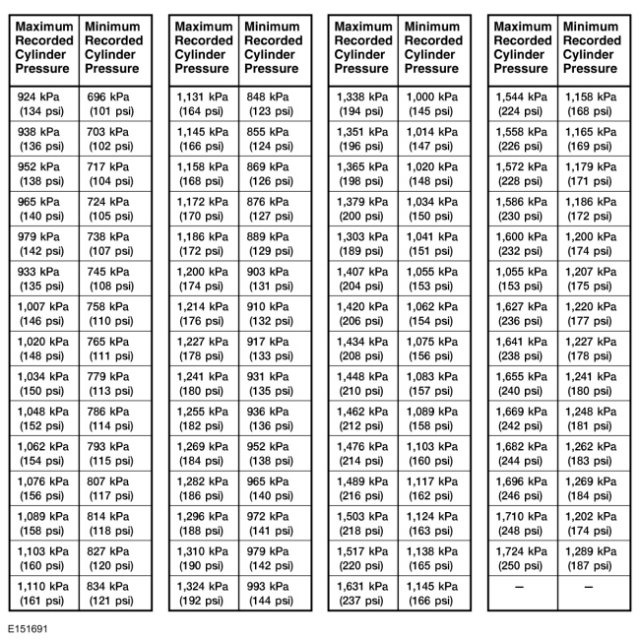-
Sign Up! To view all forums and unlock additional cool features
Welcome to the #1 Fiesta ST Forum and Fiesta ST community dedicated to Fiesta ST owners and enthusiasts. Register for an account, it's free and it's easy, so don't hesitate to join the Fiesta ST Forum today!
compression service limit
- Thread starter Stkid93
- Start date
There's no "too low" of a compression per se as you can see by this chart, everything between 101 to 250 psi is considered acceptable which is a great variation in itself. Compression is always measured between all pistons and must not have a difference greater than 25%. Per the user manual:
The indicated compression pressures are considered within specification if the lowest reading cylinder is at least 75% of the highest reading. Refer to the Compression Pressure Limit Chart.

If one or more cylinders reads low, squirt approximately one tablespoon of engine oil meeting Ford specification on top of the pistons in the low-reading cylinders. Repeat the compression pressure check on these cylinders.
Compression Test - Interpreting Compression Readings
What you may be refering to is the amount of leakage acceptable which is under 20%. Again, stated from the manual:
Cylinder Leakage Detection
When a cylinder produces a low reading, use of a cylinder leakage tester will be helpful in pinpointing the exact cause.
The leakage tester is inserted in the spark plug hole, the piston is brought up to TDC on the compression stroke, and compressed air is admitted.
Once the combustion chamber is pressurized, the leakage tester gauge will read the percentage of leakage. Leakage exceeding 20% is excessive.
While the air pressure is retained in the cylinder, listen for the hiss of escaping air. A leak at the intake valve will be heard in the Throttle Body (TB). A leak at the exhaust valve can be heard at the tailpipe. Leakage past the piston rings will be audible at the PCV connection. If air is passing through a blown head gasket to an adjacent cylinder, the noise will be evident at the spark plug hole of the cylinder into which the air is leaking. Cracks in the cylinder block or gasket leakage into the cooling system may be detected by a stream of bubbles in the radiator.
The indicated compression pressures are considered within specification if the lowest reading cylinder is at least 75% of the highest reading. Refer to the Compression Pressure Limit Chart.

If one or more cylinders reads low, squirt approximately one tablespoon of engine oil meeting Ford specification on top of the pistons in the low-reading cylinders. Repeat the compression pressure check on these cylinders.
Compression Test - Interpreting Compression Readings
- If compression improves considerably, piston rings are worn or damaged.
- If compression does not improve, valves are sticking or not seating correctly.
- If 2 adjacent cylinders indicate low compression pressures and squirting oil on each piston does not increase compression, the head gasket may be leaking between cylinders. Engine oil or coolant in cylinders could result from this condition. Use the Compression Pressure Limit Chart when checking cylinder compression so the lowest reading is within 75% of the highest reading.
What you may be refering to is the amount of leakage acceptable which is under 20%. Again, stated from the manual:
Cylinder Leakage Detection
When a cylinder produces a low reading, use of a cylinder leakage tester will be helpful in pinpointing the exact cause.
The leakage tester is inserted in the spark plug hole, the piston is brought up to TDC on the compression stroke, and compressed air is admitted.
Once the combustion chamber is pressurized, the leakage tester gauge will read the percentage of leakage. Leakage exceeding 20% is excessive.
While the air pressure is retained in the cylinder, listen for the hiss of escaping air. A leak at the intake valve will be heard in the Throttle Body (TB). A leak at the exhaust valve can be heard at the tailpipe. Leakage past the piston rings will be audible at the PCV connection. If air is passing through a blown head gasket to an adjacent cylinder, the noise will be evident at the spark plug hole of the cylinder into which the air is leaking. Cracks in the cylinder block or gasket leakage into the cooling system may be detected by a stream of bubbles in the radiator.
Similar threads
-
-
MK8 Ford Fiesta ST performance service manual & maintenance intervals
- Started by fiestanewbie
- Replies: 4
-
Timing Belt & Water Pump Service Intervals
- Started by ploobster
- Replies: 6
-
Where to get a service manual?
- Started by Dustin99
- Replies: 3
-
-
You can tell compression by the vacuum reading?
- Started by Stkid93
- Replies: 8
-
Normal PSI on compression test?
- Started by rfultz
- Replies: 11
-
Cylinder Compression Test and Borescope at 110k
- Started by VirtualRonin
- Replies: 23
-
Help 911: PLEASE REAR BRAKE CALIPER PISTON COMPRESSION?
- Started by Khill007
- Replies: 2
